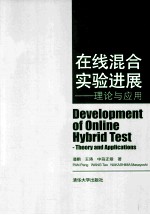

在线混合实验进展 理论与应用 英文PDF电子书下载
- 电子书积分:10 积分如何计算积分?
- 作 者:潘鹏,王涛,中岛正爱著
- 出 版 社:北京:清华大学出版社
- 出版年份:2013
- ISBN:9787302335412
- 页数:211 页
CHAPTER 1 Introduction 1
1.1 Background,objective,and challenge 1
1.2 Organization 5
REFERENCES 9
CHAPTER 2 Basics of Time Integration Algorithms 12
2.1 Introduction 12
2.2 Principle of time integration algorithms and properties 12
2.3 Development of time integration algorithms 13
2.3.1 Linear multi-step methods 13
2.3.2 Newmark's family methods 14
2.3.3 Collocation methods 15
2.3.4 α-family methods 15
2.3.5 ρ-family methods 16
2.3.6 Mixed implicit-explicit methods 16
2.4 Numerical characteristics analysis of time integration algorithms 17
2.4.1 Spectral stability 17
2.4.2 Accuracy analysis 18
2.5 Conclusions 20
REFERENCES 20
CHAPTER 3 Typical Time Integration Algorithms 23
3.1 Introduction 23
3.2 Analysis of typical time integration algorithms 23
3.2.1 Central difference method 23
3.2.2 Newmark's method 24
3.2.3 Hilber-Hughes-Taylor(HHT)-α method 26
3.2.4 Generalized-α method 28
3.2.5 Implicit-explicit method 29
3.2.6 Modal truncation technique 30
3.2.7 Integral form of existing algorithms 32
3.2.8 State space procedure 32
3.3 Applications for online hybrid test(pseudodynamic test) 34
3.3.1 Applications of central difference method 35
3.3.2 Hardware-dependent iterative scheme 36
3.3.3 Newton iterative scheme based on HHT-αmethod 37
3.3.4 α-operator-splitting(OS)method 38
3.3.5 Predictor-corrector implementation of generalized-α method(IPC-ρ∞) 39
3.3.6 Ghaboussi predictor-corrector method 40
3.4 Conclusions 41
REFERENCES 41
CHAPTER 4 Online Hybrid Test Using Mixed Control 44
4.1 Introduction 44
4.2 Presentation of the online test system 45
4.2.1 Loading system 45
4.2.2 Base-isolated structure model 48
4.2.3 Test Setup 50
4.3 Displacement-force Combined control 52
4.3.1 Static test for combined control 52
4.3.2 Algorithm of online test using displacement-force combined control 54
4.3.3 Online test using displacement-force combined control 55
4.4 Force-displacement switching control 59
4.4.1 Static test for displacement-force switching control 59
4.4.2 Algorithm of displacement-force switching control 60
4.4.3 Online test using displacement-force switching control 62
4.5 Conclusions 64
REFERENCES 65
CHAPTER 5 Internet Online Hybrid Test Using Host-Station Framework 67
5.1 Introduction 67
5.2 Presentation of the Internet online test system 69
5.2.1 System framework 69
5.2.2 Internet data exchange interface 71
5.3 Accommodation with implicit finite element program 77
5.3.1 Importance of stiffness prediction 77
5.3.2 Proposed prediction method 77
5.4 Internet online test of base-isolated structure 78
5.4.1 Base-isolated structure model 79
5.4.2 Test setup and test specimen 80
5.4.3 Test Results 82
5.5 Conclusions 85
REFERENCES 86
CHAPTER 6 Intemet Online Hybrid Test Using Separated-Model Framework 88
6.1 Introduction 88
6.2 Development of separated-model framework 89
6.2.1 Design of separated-model framework 89
6.2.2 System implementation 91
6.2.3 High-speed data exchange scheme using socket mechanism 93
6.2.4 Incorporation of finite element programs using restart capability 95
6.3 Preliminary investigations of separated-model framework 99
6.3.1 Seismic simulation of an one-story braced frame 99
6.3.2 Seismic simulation of a three-story braced frame 102
6.4 Distributed online hybrid test on a base-isolated building 106
6.4.1 Prototype structure 107
6.4.2 Numerical simulation of superstructure 108
6.4.3 Specimen for base isolation layer 109
6.4.4 Specimen for retaining walls 111
6.4.5 Test environment design 111
6.4.6 Elastic properties of structure 112
6.4.7 Pushover analysis 113
6.4.8 Quasi-static test 113
6.4.9 Earthquake response simulation 114
6.4.10 Time efficiency of experiment 116
6.5 Conclusions 118
REFERENCES 119
CHAPTER 7 Internet Online Hybrid Test Using Peer-to-Peer Framework 121
7.1 Introduction 121
7.2 Development of peer-to-peer(P2P)framework 122
7.2.1 Design of P2P framework 122
7.2.2 Iteration by quasi-Newton method 124
7.2.3 P2P Internet onlinehybrid test scheme 127
7.2.4 Incorporation of general-purpose finite element(FEM)program 130
7.3 Verification test of base-isolated structure 131
7.3.1 Structure model and substructuring 131
7.3.2 Internet online hybrid test environment 134
7.3.3 Test setup and test specimen 135
7.3.4 Test results 137
7.4 Convergence criteria on P2P Internet online hybrid test system involving structural Nonlinearities 142
7.4.1 Introduction 142
7.4.2 Investigation of convergence criteria and tolerance 143
7.4.3 Examination on type of divisions into substructures 150
7.4.4 Number of degrees of freedom on boundaries 152
7.4.5 Investigation on initial stiffness 153
7.4.6 Summary 156
7.5 Numerical characteristics of P2P predictor-corrector procedure 157
7.5.1 Introduction 157
7.5.2 Recursive matrix of two-round quasi-Newton test scheme 158
7.5.3 Stability characteristics 160
7.5.4 Accuracy characteristics 160
7.6 Conclusions 162
REFERENCES 164
CHAPTER 8 Application of online hybrid test in engineering practice 168
8.1 Introduction 168
8.2 Application example of conventional online hybrid test 168
8.2.1 Project brief 168
8.2.2 Prototype and substructures 169
8.2.3 Dynamics of the retrofitted structure 170
8.2.4 Configuration of the hybrid test system 171
8.2.5 Loading scheme 172
8.2.6 Input ground motions and intensity 173
8.2.7 Measurement scheme 174
8.2.8 Test results 174
8.3 Application example of P2P Internet online hybrid test 175
8.3.1 Project brief 175
8.3.2 Target Structure 176
8.3.3 Substructures 178
8.3.4 Improved test scheme of P2P framework 179
8.3.5 Numerical analyses by P2P framework 180
8.3.6 Distributed test environment 181
8.3.7 Implementation of tested substructures 182
8.3.8 Distributed test 183
8.3.9 Verification of P2P framework 184
8.3.10 Efficiency of P2P framework 186
8.3.11 Practical evaluation of collapse limit of the frame 187
8.3.12 Complex behavior of column bases 188
8.4 Conclusions 191
CHAPTER 9 Summary and Conclusions 193
9.1 Summary and conclusions 193
9.2 Time integration algorithms 195
9.3 Online hybrid test using mixed control 196
9.4 Internet Online Hybrid Test Using Host-Station Framework 197
9.5 Separated-model framework and its demonstration examples 197
9.6 Peer-to-peer framework and its preliminary demonstration test 199
9.7 Application of online hybrid test in engineering practice 201
APPENDIX Ⅰ List of Exiting Time Integration Algorithms 203
APPENDIX Ⅱ Implementation of OS Method 207
- 《SQL与关系数据库理论》(美)戴特(C.J.Date) 2019
- 《钒产业技术及应用》高峰,彭清静,华骏主编 2019
- 《大学计算机实验指导及习题解答》曹成志,宋长龙 2019
- 《现代水泥技术发展与应用论文集》天津水泥工业设计研究院有限公司编 2019
- 《联吡啶基钌光敏染料的结构与性能的理论研究》李明霞 2019
- 《培智学校义务教育实验教科书教师教学用书 生活适应 二年级 上》人民教育出版社,课程教材研究所,特殊教育课程教材研究中心编著 2019
- 《情报学 服务国家安全与发展的现代情报理论》赵冰峰著 2018
- 《英汉翻译理论的多维阐释及应用剖析》常瑞娟著 2019
- 《药剂学实验操作技术》刘芳,高森主编 2019
- 《新课标背景下英语教学理论与教学活动研究》应丽君 2018
- 《大学计算机实验指导及习题解答》曹成志,宋长龙 2019
- 《指向核心素养 北京十一学校名师教学设计 英语 七年级 上 配人教版》周志英总主编 2019
- 《大学生心理健康与人生发展》王琳责任编辑;(中国)肖宇 2019
- 《大学英语四级考试全真试题 标准模拟 四级》汪开虎主编 2012
- 《大学英语教学的跨文化交际视角研究与创新发展》许丽云,刘枫,尚利明著 2020
- 《北京生态环境保护》《北京环境保护丛书》编委会编著 2018
- 《复旦大学新闻学院教授学术丛书 新闻实务随想录》刘海贵 2019
- 《大学英语综合教程 1》王佃春,骆敏主编 2015
- 《大学物理简明教程 下 第2版》施卫主编 2020
- 《指向核心素养 北京十一学校名师教学设计 英语 九年级 上 配人教版》周志英总主编 2019
